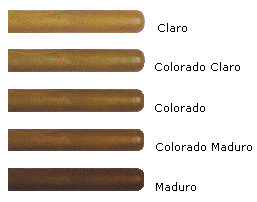 Cigar Production Cigar Production
Production methods and processes are as follows:
Unpacking
Unpacking involves carefully unpacking and moistening of the leaf to avoid damage, especially to the
wrapper leaf. This is done in special airing rooms.
Blending
Blending is done to a specific standard set for each brand and individual vitola.
The details of these blends are only known to Tabacuba (who own the fields, processing houses, and factories).
The Master Blender selects from the available leaf to achieve the required blend for each vitola to be produced.
The correct amount of leaf is then supplied to each roller in batches, to be incorporated into complete cigars.
Small gauge cigars with a ring size of less than 36, do not contain any Ligero leaf.
Handmade Cigars - Totalmente a Mano Tripa Larga (long filler)
For fully handmade cigars, the roller (Torcedora) first lays out the binder leaf.
The full size (Tripa Larga) filler leaves are then gathered, folded, and aligned (to ensure a clear passage) .
The leaves are arranged with the lighter flavoured tips at the foot of the cigar.
The stronger flavoured slower burning Ligero leaf is placed along the centre of the cigar.
Next the bunch is formed by rolling the filler onto the laid-out binder leaf, starting at the foot.
The head of the bunch is guillotined and the bunch is pressed into a timber mould to form the shape.
After this stage, the bunches are subject to a suction draw test.
This testing commenced circa 2002; initially only random cigars were suction tested for minimum draw pressure.
Now every cigar undergoes a suction test to satisfy both minimum and maximum draw pressures.
The wrapper is then prepared, smooth side out.
After trimming the exposed edge, the formed bunch is laid on the wrapper and rolled, starting at the cigar's foot.
The cap is then fitted and the cigar guillotined to length.
Handmade Short-Filler Cigars - Totalmente a Mano Tripa Corta
Handmade Short Filler cigars have a filler composed of leaf trimmings
from the bunches of long filler cigars combined with other selected chopped tobacco, but full size binders and wrappers are used.
Some short-filler cigars are still produced by Habanos SA.
Machine-made Cigars - Mecanizado
Machine-made cigars were produced from the 1950s and were made with either long or short filler tobacco.
They could be produced in large quantities and were significantly cheaper than hand-made cigars.
Almost all machine-made cigars were once produced in both fully machine-made and hand-finished versions.
There was a significant phasing out of machine-made cigars between 2002 and 2005.
By 2006, no machine made cigars remained in the Habanos SA range.
Hand-Finished Cigars
Machine-bunched hand-finished cigar had the filler and binder bunched by machine but the wrapper was applied by hand.
Hand finishing of machine bunched cigars (by the hand application of the wrapper) was reduced in the 1990s
and was fully phased out by circa 2002.
No longer produced by Habanos SA.
Small Cigars
Small cigars are classified as machine-made cigars that weigh less than 3 grams and use short filler tobacco.
They are available in some Cuban cigar brand names. This range includes the Mini, Club, and Puritos.
Before circa 2001, they were produced outside Cuba using 100% Cuban Tobacco.
Since then they have been produced in Cuba and therefore can be legally called Cuban cigars.
In circa 2005 mini cigars were taken out of the Habanos range, and are now produced by Internacional Cubana de Tabacos, S.A.
Cigarettes
Cigarettes made from Cuban tobacco are available in some Cuban cigar brand names.
Cigarettes are not listed in this website.
Fumigation & Conditioning
Before packing, the cigars are fumigated with Phosphine (Phosphorus
Hydride) to control the tobacco beetle Serricorne, and then conditioned in bundles in cedar lined
cabinets, to reduce and stabilise their moisture.
These cabinets are maintained between 16°C - 18°C and 65% - 70% RH.
Quality Control
Quality control is provided by testing and supervision during the rolling, and
later by both non-destructive and destructive testing.
The supervisors are expert rollers, who are mainly involved in
checking technique, construction and physical cigar sizes at the rolling tables.
Each cigar must pass a suction draw test before the wrapper is applied.
After leaving the roller, the cigars go to the quality control
section, where each cigar is checked for weight, length, ring size,
consistency, construction and appearance.
Samples are also opened up to check internal filler construction, arrangement, and blending of the leaf.
Finally, a sample of the cigars are test-smoked to ensure that they
are consistent with the required character of the vitola.
They are graded for draw, burn, aroma, flavour, strength, and overall quality.
General consensus is that there has been a substantially overall improvement in Cuban cigars (due to improved and additional quality
control and the older aged filler leaf now being used). This improvement has been especially apparent since 2006 and these cigars
now smoke better and earlier.
Freezing
In addition to fumigation, freezing of the finished cigars is used to
kill the tobacco beetle Lasioderma serricorne.
Freezing of cigars commenced around early 2005.
It is carried out in the Habanos main temperature and humidity controlled storage and distribution building.
This, combined with fumigation, is intended to kill all eggs, insects, and lava within the tobacco.
Some regional distributors had their own freezing facilities, predating the Habanos plant.
For details of the Tobacco Beetle and other Pests.....
click here.
Wrapper Shades
 Wrappers have a basic colour classification as shown.
Wrappers have a basic colour classification as shown.
There are many shades within each basis colour. As far as possible, cigars
of the same shade are allocated to a single box.
When there is a slight difference, the shades are arranged
to run from darker to lighter, from left to right across the box.
|